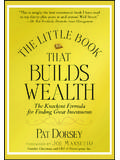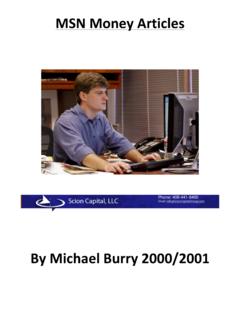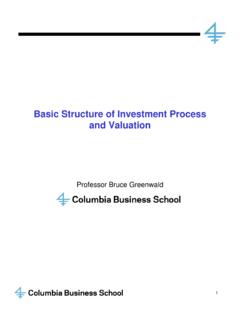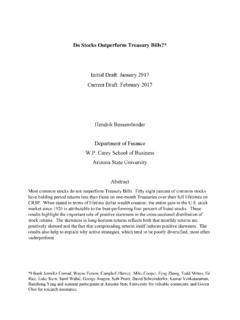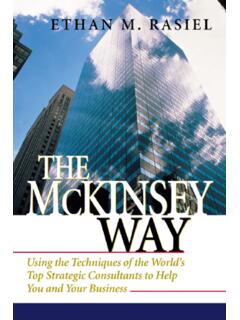Transcription of BAGGERS - csinvesting
1 100. BAGGERS . STOCKS THAT RETURN 100-TO-1 AND HOW TO FIND THEM. 100. BAGGERS . STOCKS THAT RETURN 100-TO-1 AND HOW TO FIND THEM. CHRISTOPHER MAYER. Laissez Faire Books In memory of Thomas W. Phelps, author of the first book on 100- BAGGERS Copyright Agora Financial, LLC, 2015. All rights reserved. ISBN: 978-1-6212916-5-7. 19 18 17 16 15 1234567. Published by Laissez Faire Books, 808 St. Paul Street, Baltimore, Maryland Cover and Layout Design: Andre Cawley CONTENTS. Chapter 1: Introducing Chapter 2: Anybody Can Do This: True 11. Chapter 3: The Coffee-Can 15. Chapter 4: 4 Studies of 31. Chapter 5: The 100- BAGGERS of the Last 50 Chapter 6: The Key to 75. Chapter 7: Owner-Operators: Skin in the Chapter 8: The Outsiders: The Best Chapter 9: Secrets of an 18, 103. Chapter 10: Kelly's Heroes: Bet Chapter 11: Stock Buybacks: Accelerate Chapter 12: Keep Competitors Chapter 13: Miscellaneous Mentation on 129.
2 Chapter 14: In Case of the Next Great Chapter 15: 100- BAGGERS Distilled: Essential 169. Appendix The 100- BAGGERS (1962 2014).. 191. CHAPTER 1: INTRODUCING 100- BAGGERS . This book is about 100- BAGGERS . These are stocks that return $100 for every $1 invested. That means a $10,000 investment turns into $1,000,000. In this book, I want to show you how you can find them. I know, I know. It sounds like an outrageous quest with a wildly im- probable chance of success, like setting out to draw a royal flush in poker. And I would probably have agreed with you not so long ago. But then I started to dig in and study these 100- BAGGERS . Definite patterns emerged. Let's set out what this book will do for you: You will learn the key characteristics of 100- BAGGERS . There are only so many ways up the mountain, and we'll map out these paths in what follows.
3 You will learn why anybody can do this. It is truly an every- man's approach. You don't need an MBA or a finance degree. Some basic financial concepts are all you'll need. I'll share with you a number of crutches or techniques that can help you get more out of your stocks and investing. The emphasis is always on the practical, and so there are many stories and anecdotes to help illustrate important points. 2 100- BAGGERS . You should read this book if you want to get more out of your stocks. Even if you never get a 100-bagger, this book will help you turn up big winners and keep you away from sleepy stocks that go nowhere. If you like investing in utility stocks, with their limited upsides, then this book isn't for you. This book will change the way you think about investing in stocks. You will never look at the problem in quite the same way again.
4 I hope it will energize and excite you about what's possible. Before I get to the specifics of how to find 100- BAGGERS , let me give you some context that helps frame the whole effort. The story of this book begins in 2011. That year , I read remarks inves- tor Chuck Akre made at a conference held that same year . (Akre is a great investor, and we will meet him again in the last chapter.) The title of his talk was An Investor's Odyssey: The Search for Outstanding Investments.. Here is part of what he said: In 1972, I read a book that was reviewed in Barron's and this book was called 100 to 1 in the Stock Market by Thomas Phelps. He represented an analysis of investments gaining 100 times one's starting price. Phelps was a Boston investment manager of no particular reputation, as far as I know, but he certainly was on to something, which he outlined in this book.
5 Reading the book really helped me focus on the issue of compounding capital. Also, from Boston, you all know Peter Lynch, who often spoke about ten- BAGGERS . Here was Phelps talking about 100- BAGGERS , so what's the deal? Well Phelps laid out a series of examples where an investor would in fact have made 100 times his money. Further he laid out some of the characteristics, which would compound these investments. I had never heard of the book. And I've read all the investment classics and many obscure ones. So, I quickly got hold of a copy and began to read. It became one of my favorite investing books. In December of that year , I sat down and wrote the following story for readers of my newsletter. It serves as an introduction to Phelps and the ideas we'll explore more in this book. INTRODUCING 100- BAGGERS 3.
6 Every Problem Is an Investment Opportunity Every human problem is an investment opportunity if you can anticipate the solution, the old gentleman told me. Except for thieves, who would buy locks? . I just met this remarkable fellow, full of wisdom on investing, yet hardly known beyond a small group of fans. His name is Thomas Phelps, and he's had quite a career. He was the Wall Street Journal's Washington bureau chief, an editor of Barron's, a partner at a brokerage firm, the head of the research department at a Fortune 500 company, and, finally, a partner at Scudder, Stevens & Clark (since bought out by Deutsche Bank). Phelps retired in Nantucket after a varied 42- year career in markets. Along the way, Phelps figured out a few things about investing. He con- ducted a fascinating study on stocks that returned $100 for every $1.
7 Invested. Yes, 100 to 1. Phelps found hundreds of such stocks, bunches available in any single year , that you could have bought and enjoyed a 100-to-1 return on if you had just held on. This was the main thrust of our conversation: the key is not only finding them, but keeping them. His basic conclusion can be summed up in the phrase buy right and hold on.. Let's face it, he said: a great deal of investing is on par with the instinct that makes a fish bite on an edible spinner because it is moving. Investors too bite on what's moving and can't sit on a stock that isn't going anywhere. They also lose patience with one that is moving against them. This causes them to make a lot of trades and never enjoy truly mammoth returns. Investors crave activity, and Wall Street is built on it. The media feeds it all, making it seem as if important things happen every day.
8 Hundreds of millions of shares change hands every session. But investors need to distinguish between activity and results. When I was a boy, a carpenter working for my father made this sage observa- tion: A lot of shavings don't make a good workman.' As you can see, Phelps is a man of folksy wisdom. Investors, Phelps continued, have been so thoroughly sold on the nonsensical idea of measuring performance quarter by quarter or even 4 100- BAGGERS . year by year that many of them would hit the ceiling if an investment adviser or portfolio manager failed to get rid of a stock that acted badly for more than a year or two.. What investors should do is focus on the business, not on market prices. Phelps showed me financial histories of a long list of companies . earnings per share, returns on equity and the like.
9 No stock prices. After one example, he asked, Would a businessman seeing only those figures have been jumping in and out of the stock? I doubt it. But if they just sat on it, they'd be rich. And this is the nub of it. Phelps is not a fan of selling good businesses. He talked about how his friend Karl Pettit an industrialist, inventor and investor sold his shares of IBM stock many years ago to start his brokerage business. He sold them for a million bucks. That stake would eventually go on to be worth $2 billion more than he ever made in his brokerage business. Phelps told me the story of how he sold his Polaroid stock to pay a steep doctor's bill of $7,415 back in 1954. Here is the confirmation of the sale, he said, and he keeps it as a reminder of his folly. Less than 20. years later, his Polaroid stock was worth $843,000.
10 That's an expensive doctor's visit. Phelps also stands against market timing. He told me about how he predicted various bear markets in his career. Yet I would have been much better off if instead of correctly forecasting a bear market, I had fo- cused my attention through the decline on finding stocks that would turn $10,000 into a million dollars.. Because of his bearishness, he missed opportunities that went on to deliver 100 to 1. Bear market smoke gets in one's eyes, he said, and it blinds us to buying opportunities if we are too intent on market timing. He who lives by the sword shall perish by the sword, he added. When experienced investors frown on gambling with price fluctuations in the stock market, it is not because they don't like money, but because both experience and history have convinced them that enduring fortunes are not built that way.

